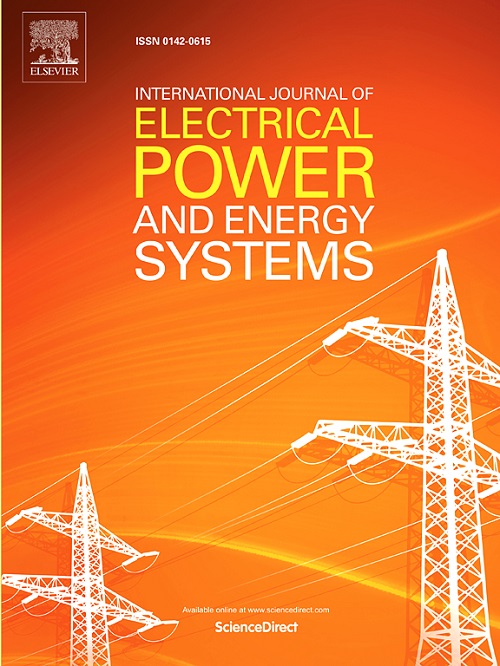分数阶CES控制在具有积分RESs的非调节现实电力系统中的频率调节
IF 5
2区 工程技术
Q1 ENGINEERING, ELECTRICAL & ELECTRONIC
International Journal of Electrical Power & Energy Systems
Pub Date : 2025-09-27
DOI:10.1016/j.ijepes.2025.111049
引用次数: 0
摘要
在与可再生能源集成的竞争性电力系统的频率调节(FR)中,帮助自动发电控制(AGC)的一个有效解决方案是为快速响应存储(如电容储能(CES))提供补充控制器。以前的CES模型没有专门针对CES动力学提出,也没有固定的参数,导致无法对FR问题做出积极贡献。因此,在独家CES模型上建立的有效控制方法的丧失代表了一个值得进一步调查的重大差距。为了有效地解决混合能源系统中的FR问题,提出了一种基于非整数阶控制器(noc)的初始控制方法,并将其应用于混合能源系统的独占动力学。结合光伏、风能、天然气、再热热和水力发电厂的两区自由混合能源系统具有固有的非线性,包括发电速率约束、通信时间延迟(CTDs)、调速器死区和锅炉动力学,被认为可以获得现实的愿景和可靠的输出。cse - agc并行设计方法被认为是性能增强方法。据此,采用元启发式算法最小化了时间加权平方误差(ITSE)指数的积分。数值分析和时域仿真结果表明,基于分数阶比例积分导数(FOPID)的es - agc策略是抑制区域频率偏差和钩线误差功率响应的最有效控制策略。采用所提出的基于fopid的CES-AGC,与基于铅滞后的CES-AGC和基于pid的CES-AGC相比,峰值幅度(MP) ΔF1大幅降低了近17 ~ 13.8倍,MP ΔF2大幅降低了2.2 ~ 2.4倍,ITSE大幅降低了22 ~ 1.7倍,ISE大幅降低了9.5 ~ 1.8倍,最小阻尼比(ζmin)提高了近8 ~ 3.7倍,从而显著改善了阻尼准则。同时,基于fopid的CES-AGC在与FR问题相关的阻尼指标上优于基于倾斜积分导数(TID)的CES-AGC。此外,与基于铅-滞后的CES-AGC和基于pid的CES-AGC相比,采用所提出的基于pid的CES-AGC,稳定性措施得到了显著改善,其中ΔF1的MP降低了近4.3至3.5倍,ΔF2的MP降低了1.3至1.5倍,ITSE的MP降低了17至1.3倍,ISE的MP降低了7.9至1.5倍,而ζmin的稳定性措施则分别提高了约5.6至2.6倍。数值分析和时域模拟表明,采用基于noc的控制策略可以有效地抑制振荡。此外,通过确定系统的最大耐受CTD来评估所提出的基于nocs的控制方法的弹性。结果表明,即使考虑最大可容忍CTD,这里是3秒,如果在所提出的控制器的调谐中考虑到这一点,也可以实现显着的阻尼性能。灵敏度分析表明,基于ncs - agc的系统负载和同步系数参数分别对±20%和±25%的变化具有鲁棒性。本文章由计算机程序翻译,如有差异,请以英文原文为准。
Fractional order CES control for frequency regulation in deregulated realistic power systems with integrating RESs
One efficient solution to aid automatic generation control (AGC) in frequency regulation (FR) of competitive power systems integrated with renewables is to offer supplementary controllers for fast-response storage, such as capacitive energy storage (CES). Former CES models have not been presented exclusively for the CES dynamics or have fixed parameters, leading to a failure to contribute actively to the FR issue. Accordingly, the loss of an effective control approach established on the exclusive CES model represents a significant gap that warrants further investigation. To effectively contribute to the FR issue in a hybrid energy system, a maiden control approach based upon non-integer order controllers (NOCs) is offered for application in the exclusive dynamics of CES. A two-area liberal hybrid energy system incorporating photovoltaic, wind, gas, reheat thermal, and hydro plants with intrinsic nonlinearities, including generation rate constraints, communication time delays (CTDs), governor dead bands, and boiler dynamics, is considered to attain a realistic vision and reliable outputs. A CES-AGC concurrent design approach is regarded as performance-reinforcing. Accordingly, the integral of time-weighted squared error (ITSE) index is minimized using metaheuristic algorithms. The numerical analyses and time-domain simulations under an utterly liberal scenario demonstrate that the offered fractional order proportional integral derivative (FOPID)-based CES-AGC strategy is the most effective control strategy for suppressing deviations in area frequency and tie-line error power responses. Employing the proposed FOPID-based CES-AGC achieves a significant improvement in the damping criteria through a substantial reduction of nearly 17 to 13.8 times in peak magnitude (MP) of ΔF1, 2.2 to 2.4 times in MP of ΔF2, 22 to 1.7 times in ITSE, 9.5 to 1.8 times in ISE, and an increase of nearly 8 to 3.7 times in the minimum damping ratio (ζmin) compared to the lead-lag-based CES-AGC and PID-based CES-AGC, in order. Meanwhile, the FOPID-based CES-AGC outperforms the tilt integral derivative (TID)-based CES-AGC in the damping metrics associated with the FR issue. Moreover, by employing the proposed TID-based CES-AGC, a significant improvement in stability measures is obtained via a considerable reduction of closely 4.3 to 3.5 times in MP of ΔF1, 1.3 to 1.5 times in MP of ΔF2, 17 to 1.3 times in ITSE, 7.9 to 1.5 times in ISE, and an increase of approximately 5.6 to 2.6 times in the ζmin when compared with the lead-lag-based CES-AGC and PID-based CES-AGC counterparts, respectively. Additional numerical analyses and time-domain simulations, under various contract violation scenarios, indicate that employing the offered control strategy based on the NOCs has substantially confined the oscillations. Furthermore, the resiliency of the presented NOCs-based control approach is evaluated by determining the system’s maximum tolerable CTD. It is demonstrated that even with considering the maximum tolerable CTD, here 3 s, a remarkable damping performance can be achieved if it is taken into account in the tuning of the proposed controllers. Sensitivity analyses reveal that the NOCs-based CES-AGC is robust against ± 20 % and ± 25 % changes in the system loading and the synchronizing coefficient parameter, respectively.
求助全文
通过发布文献求助,成功后即可免费获取论文全文。
去求助
来源期刊
CiteScore
12.10
自引率
17.30%
发文量
1022
审稿时长
51 days
期刊介绍:
The journal covers theoretical developments in electrical power and energy systems and their applications. The coverage embraces: generation and network planning; reliability; long and short term operation; expert systems; neural networks; object oriented systems; system control centres; database and information systems; stock and parameter estimation; system security and adequacy; network theory, modelling and computation; small and large system dynamics; dynamic model identification; on-line control including load and switching control; protection; distribution systems; energy economics; impact of non-conventional systems; and man-machine interfaces.
As well as original research papers, the journal publishes short contributions, book reviews and conference reports. All papers are peer-reviewed by at least two referees.

 求助内容:
求助内容: 应助结果提醒方式:
应助结果提醒方式:


